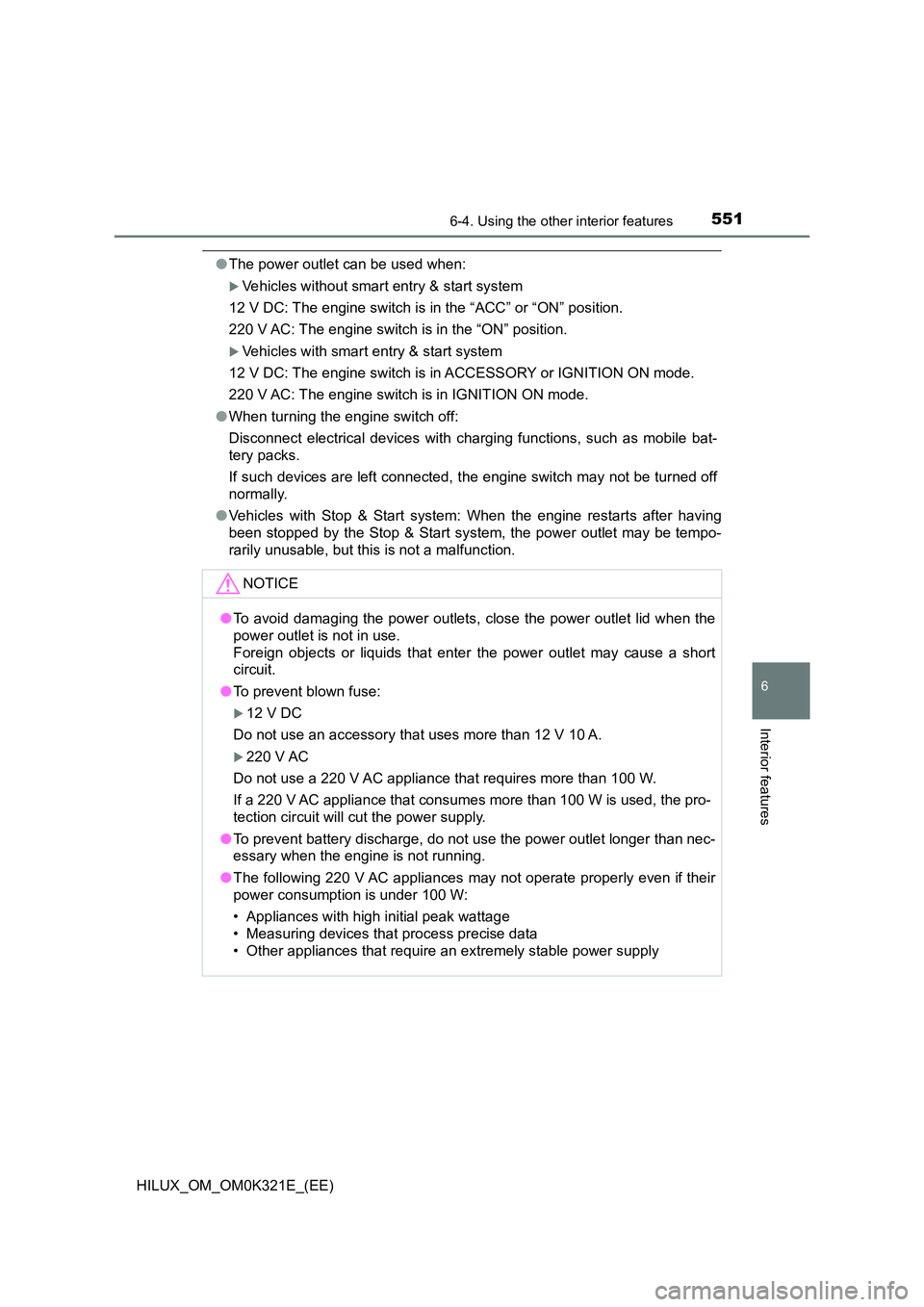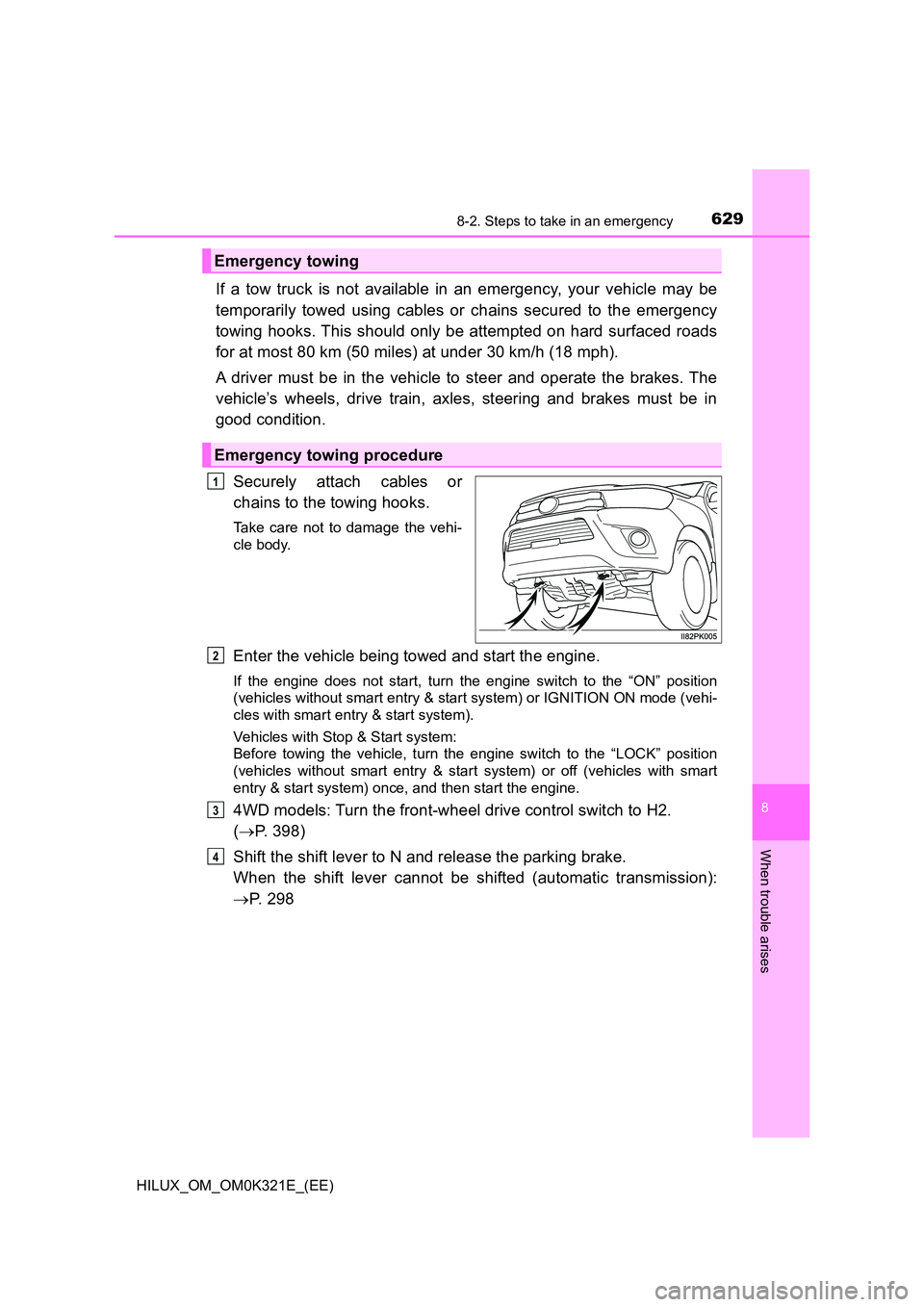Page 551 of 744

5516-4. Using the other interior features
HILUX_OM_OM0K321E_(EE)
6
Interior features
●The power outlet can be used when:
Vehicles without smart entry & start system
12 V DC: The engine switch is in the “ACC” or “ON” position.
220 V AC: The engine switch is in the “ON” position.
Vehicles with smart entry & start system
12 V DC: The engine switch is in ACCESSORY or IGNITION ON mode.
220 V AC: The engine switch is in IGNITION ON mode.
● When turning the engine switch off:
Disconnect electrical devices with charging functions, such as mobile bat-
tery packs.
If such devices are left connected, the engine switch may not be turned off
normally.
● Vehicles with Stop & Start system: When the engine restarts after having
been stopped by the Stop & Start system, the power outlet may be tempo-
rarily unusable, but this is not a malfunction.
NOTICE
● To avoid damaging the power outlets, close the power outlet lid when the
power outlet is not in use.
Foreign objects or liquids that enter the power outlet may cause a short
circuit.
● To prevent blown fuse:
12 V DC
Do not use an accessory that uses more than 12 V 10 A.
220 V AC
Do not use a 220 V AC appliance that requires more than 100 W.
If a 220 V AC appliance that consumes more than 100 W is used, the pro-
tection circuit will cut the power supply.
● To prevent battery discharge, do not use the power outlet longer than nec-
essary when the engine is not running.
● The following 220 V AC appliances may not operate properly even if their
power consumption is under 100 W:
• Appliances with high initial peak wattage
• Measuring devices that process precise data
• Other appliances that require an extremely stable power supply
Page 575 of 744

5757-3. Do-it-yourself maintenance
HILUX_OM_OM0K321E_(EE)
7
Maintenance and care
■After changing the engine oil (models for model code destination W*)
The engine oil maintenance data should be reset. Perform the following pro-
cedures:
Switch the display to the trip meter A ( P. 144) when the engine switch is
in the “ON” position (vehicles without smart entry & start system) or IGNI-
TION ON mode (vehicles with smart entry & start system).
Turn the engine switch to the “LOCK” position (vehicles without smart entry
& start system) or off (vehicles with smart entry & start system).
While pressing the odometer/trip meter display change button ( P. 144),
turn the engine switch to the “ON” position (vehicles without smart entry &
start system) or IGNITION ON mode (vehicles with smart entry & start sys-
tem). (Do not start the engine because reset mode will be canceled.) Con-
tinue to press and hold the button for more than one second after the trip
meter displays “000000”.
*: See “Checking your vehicle’s model” if you are not sure of which model
your vehicle is. ( P. 1 2 )
WARNING
■Used engine oil
● Used engine oil contains potentially harmful contaminants which may
cause skin disorders such as inflammation and skin cancer, so care
should be taken to avoid prolonged and repeated contact. To remove used
engine oil from your skin, wash thoroughly with soap and water.
● Dispose of used oil and filters only in a safe and acceptable manner. Do
not dispose of used oil and filters in household trash, in sewers or onto the
ground. Call any authorized Toyota reta iler or Toyota authorized repairer,
or any reliable repairer, service station or auto parts store for information
concerning recycling or disposal.
● Do not leave used engine oil within the reach of children.
NOTICE
■To prevent serious engine damage
Check the oil level on a regular basis.
■ When replacing the engine oil
● Be careful not to spill engine oil on the vehicle components.
● Avoid overfilling, or the engine could be damaged.
● Check the oil level on the dipstick every time you refill the vehicle.
● Be sure the engine oil filler cap is properly tightened.
1
2
3
Page 629 of 744

6298-2. Steps to take in an emergency
HILUX_OM_OM0K321E_(EE)
8
When trouble arises
If a tow truck is not available in an emergency, your vehicle may be
temporarily towed using cables or chains secured to the emergency
towing hooks. This should only be attempted on hard surfaced roads
for at most 80 km (50 miles) at under 30 km/h (18 mph).
A driver must be in the vehicle to steer and operate the brakes. The
vehicle’s wheels, drive train, axles, steering and brakes must be in
good condition.
Securely attach cables or
chains to the towing hooks.
Take care not to damage the vehi-
cle body.
Enter the vehicle being towed and start the engine.
If the engine does not start, turn the engine switch to the “ON” position
(vehicles without smart entry & start system) or IGNITION ON mode (vehi-
cles with smart entry & start system).
Vehicles with Stop & Start system:
Before towing the vehicle, turn the engine switch to the “LOCK” position
(vehicles without smart entry & start system) or off (vehicles with smart
entry & start system) once, and then start the engine.
4WD models: Turn the front-wheel drive control switch to H2.
( P. 398)
Shift the shift lever to N and release the parking brake.
When the shift lever cannot be shifted (automatic transmission):
P. 2 9 8
Emergency towing
Emergency towing procedure
1
2
3
4
Page 631 of 744

6318-2. Steps to take in an emergency
HILUX_OM_OM0K321E_(EE)
8
When trouble arises
NOTICE
■To prevent damage to the vehicle when towing using a wheel-lift type
truck
● Do not tow the vehicle from the rear when the engine switch is in the
“LOCK” position or the key is removed (vehicles without smart entry & start
system) or the engine switch is turned to off (vehicles with smart entry &
start system). The steering lock mechanism is not strong enough to hold
the front wheels straight.
● When raising the vehicle, ensure adequate ground clearance for towing at
the opposite end of the raised vehicle. Without adequate clearance, the
vehicle could be damaged while being towed.
■ To prevent damage to the vehicle when towing with a sling-type truck
Do not tow with a sling-type truck, either from the front or rear.
■ To prevent damage to the vehicle during emergency towing
Do not secure cables or chains to the suspension components.
■ When towing a vehicle equipped with the Stop & Start system (if
equipped)
When it is necessary to tow the vehicle with all four wheels contacting the
ground, perform the following procedure before towing the vehicle to protect
the system.
Turn the engine switch to the “LOCK” position (vehicles without smart entry
& start system) or off (vehicles with smart entry & start system) once, and
then start the engine. If the engine does not start, turn the engine switch to
the “ON” position (vehicles without smart entry & start system) or IGNITION
ON mode (vehicles with smart entry & start system).
Page 669 of 744
6698-2. Steps to take in an emergency
HILUX_OM_OM0K321E_(EE)
8
When trouble arises
Automatic transmission
Ensure that the shift lever is in P and depress the brake pedal.
Touch the area behind the lock
button and unlock button on the
electronic key to the engine
switch.
When the electronic key is
detected, a buzzer sounds and the
engine switch will turn to IGNITION
ON mode.
When the smart entry & start sys-
tem is deactivated in customization
setting, the engine switch will turn
to ACCESSORY mode.
Firmly depress the brake pedal.
A message indicating how to start the engine will be displayed on the
multi-information display.
Press the engine switch.
In the event that the engine still cannot be started, contact any autho-
rized Toyota retailer or Toyota authorized repairer, or any reliable
repairer.
Starting the engine
1
2
3
4
Page 670 of 744
6708-2. Steps to take in an emergency
HILUX_OM_OM0K321E_(EE)
Manual transmission
Ensure that the shift lever is in N and depress the clutch pedal.
Touch the area behind the lock
button and unlock button on the
electronic key to the engine
switch.
When the electronic key is
detected, a buzzer sounds and the
engine switch will turn to IGNITION
ON mode.
When the smart entry & start sys-
tem is deactivated in customization
setting, the engine switch will turn
to ACCESSORY mode.
Firmly depress the clutch pedal.
A message indicating how to start the engine will be displayed on the
multi-information display.
Press the engine switch.
In the event that the engine still cannot be started, contact any autho-
rized Toyota retailer or Toyota authorized repairer, or any reliable
repairer.
1
2
3
4
Page 673 of 744
6738-2. Steps to take in an emergency
HILUX_OM_OM0K321E_(EE)
8
When trouble arises
Diesel engine (vehicles without water-cooled intercooler)
Diesel engine (vehicles with water-cooled intercooler)
Start the engine of the second vehicle. Increase the engine speed
slightly and maintain at that level for approximately 5 minutes to
recharge the battery of your vehicle.
Vehicles with smart entry & start system: Open and close any of the
doors with the engine switch off.
Maintain the engine speed of the second vehicle and start the
engine of your vehicle by turning the engine switch to the “ON”
position (vehicles without smart entry & start system) or IGNITION
ON mode (vehicles with smart entry & start system).
324
1
3
4
5
Page 707 of 744
707
9
9-1. Specifications
Vehicle specifications
HILUX_OM_OM0K321E_(EE)
Vehicles with maintenance type battery
Vehicles with maintenance-free type battery
Ignition system (gasoline engine)
Spark plug
MakeDENSO FK20HR-A8
Gap0.8 mm (0.031 in.)
NOTICE
■Iridium-tipped spark plugs
Use only iridium-tipped spark plugs. Do not adjust the spark plug gap.
Electrical system
Battery
Specific gravity reading
at 20 C (68F):
1.25 or higher
If the specific gravity is lower than the standard
value, charge the battery.
Charging rates
Quick charge
Slow charge
15 A max.
5 A max.
Battery
Open voltage at 20 C
(68 F):
12.3 V or higher
If the voltage is lower than the standard value,
charge the battery.
(After charging the battery, turn on the high
beam headlights for 30 seconds with the engine
switch in the “LOCK” position [vehicles without
smart entry & start system] or off [vehicles with
smart entry & start system], and turn the head-
lights off.)
Charging rates 5 A max.